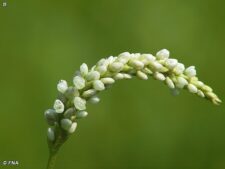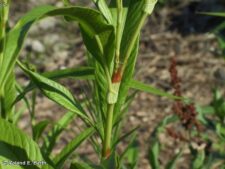
PALE SMARTWEED
Persicaria lapathifolia
BUCKWHEAT FAMILY (Polygonaceae)
 Identification
Identification
- Flowering time - June, July, August, September, October
- Common in some years on floodplain at FF & NW
- Largest of our smartweeds
- Long, nodding densely packed flower clusters
- No bristles on stem sheaths
This annual has stout stems from 2-6 feet tall. At the point where the leaves join it, the stem is swollen and wrapped in a brown membranous sheath (ochrea) which has no bristles (A,C). Alternate, lance-shaped leaves with smooth margins are up to 8 inches long. Long, densely packed nodding clusters of small greenish-white or pale pink flowers occur at the end of upper stems. (B). Their 4 or 5 tepals (petals and similar sepals) are seldom seen because the flowers are small (1/8 inch) and usually closed or only partially open.
Common in some years on the floodplain at Fontenelle Forest and Neale Woods, it can quickly establish itself on the bare soil of recently flooded areas, streambanks and marsh edges. Flowering occurs from June to October.
Other common names include Nodding Smartweed, Curlytop Knotweed and Willowweed.
The seeds of this species and other smartweeds are an important food source for waterfowl and wetland songbirds.
The content of NatureSearch is provided by dedicated volunteer Naturalists of Fontenelle Forest who strive to provide the most accurate information available. Contributors of the images retain their copyrights. The point of contact for this page is: Roland Barth.


